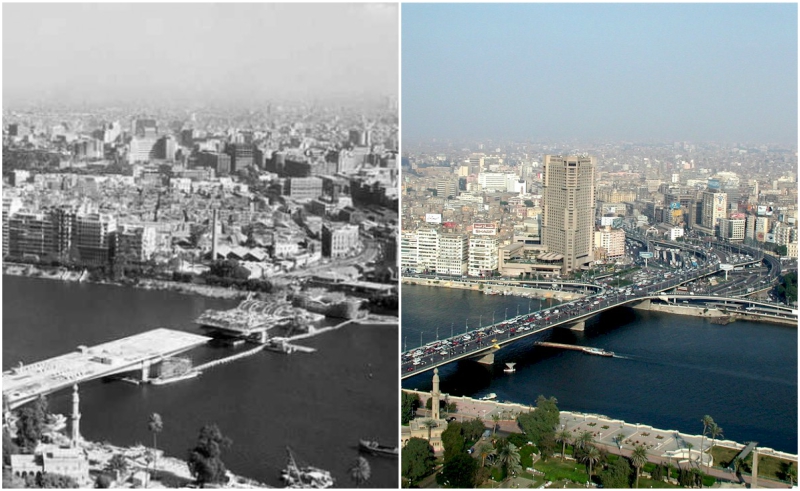The Tale of October 6th Bridge, Africa's Longest Flyover
An in-depth look with photos into the overlooked history of Cairo's iconic bridge and how the 1969 visionary plan only became a concrete reality in the late 1990s.

Once upon a time in an aging megacity on the banks of the Nile, a staggering hike in the number of vehicles in the city paralysed its streets. So much so that in 1969, 65 thousand vehicles* (cars, buses and motorcycles) were roaming the tightly-packed, underprepared streets of Cairo, ushering in a period of unprecedented traffic congestion in the fast-growing metropolis. Over the course of 1969, three thousand more official licenses were issued for different types of vehicles, further worsening the situation.
 Traffic in 1969 Cairo, Al Mosawer Magazine
Traffic in 1969 Cairo, Al Mosawer Magazine
With construction picking up in then-remote areas like Nasr City and Heliopolis to meet the increasing housing demands of the city's booming population, the need to connect the entirety of the city and ease the suffocating traffic situation arose, leading to emergence of construction plans of an elevated highway that later became known as the 6th of October Bridge, which was officially brought to life in 1969 with a presidential decree by President Gamal Abdel-Nasser. The prominent Arab Contractors company was green-lit to begin construction in mid-1969, with the bridge's modest first phase connecting El Gezira to Agouza being completed in 1972, over two years after the passing of Gamal Abdel Nasser. During construction's 4th phase, Egypt successfully crossed the Suez Canal into occupied Sinai on the 6th of October 1973, which led to altering the name of the new project from Ramsis Bridge to the 6th of October bridge, in commemoration of the victorious crossing.
The bridge quickly became the epitome of Egyptian modern construction and got designated as a national project, similarly to the Aswan High Dam. Egyptian officials propagated the bridge as an open-to-all observatory tower for citizens, from which they can enjoy the view of numerous Cairo landmarks during their daily commutes, including the Maspero television building, Cairo Tower, the Egyptian Museum and the majesty of the Nile river.
The 22 KM structure was built over 8 phases and took almost 30 years to be completed due to the tough economic situation Egypt was in following the devastating war, which brought construction efforts to a complete halt for a whole decade. The bridge cost reached almost EGP 200 million in total**, with its final phase being completed in 1996, giving a new lifeline to the suffocated metropolis and becoming the longest bridge on the continent of Africa until today, according to Structrae, The International Database for Civil and Structural Engineering.
 The bridge during construction/Archive Egypt
The bridge during construction/Archive Egypt
The bridge faced many obstacles on its way to completion, most notably All Saints Cathedral, home to the Episcopal/Anglican diocese in Egypt and North Africa, which was built in 1938 in the centre of what is now Abdel Mon'em Riyad Square. The church was situated in the very middle of the project, restricting its expansion to eastern Cairo and Ramsis square. President Anwar Al-Sadat eventually (and controversially) ordered the demolition of the church in 1978, replacing it with the new All Saints Cathedral in Zamalek, which still stands until today.
 The original All-Saints Cathedral, Abdel Mon'em Riyad
The original All-Saints Cathedral, Abdel Mon'em Riyad

The replacement All-Saint Cathedral, Zamalek
The flyover, which has 23 exits, remains the primary traffic artery connecting the cities of Cairo and Giza. Before the bridge was completed, there was only one road (now Salah Salem Avenue) connecting central Cairo to the eastern neighborhood of Heliopolis and Cairo International Airport, which were almost completely detached from the rest of the city at the time.
 Pinterest
Pinterest
Today, Cairo stands as Africa's and the Middle East's most populated city, and one of the biggest in the world. The city is now connected through a network of highways surrounding and penetrating it. The extensive road network, however, still manages to falls short in meeting the skyrocketing demand and growth in the number of vehicles, which hit a mind-boggling 3 million vehicles*** as of 2016, leading to a horrendous traffic situation which costs the city's economy USD 8 billion annually in lost productivity, according to the World Bank's figures.
The 6th of October bridge remains the main internal artery connecting the city, nevertheless becoming synonymous with all-day rush hours and unbearable traffic congestion. The current Egyptian government is undertaking numerous infrastructure projects and inaugurating new highways and roads all around the city. But with Cairo becoming home to almost half a million newborns in 2016 alone and being designated as one of the world's worst cities for commuters, it seems unlikely that the city's notorious traffic reputation will subside anytime soon. The bridge was built in a bid to end traffic in the overly-congested city. But almost half a decade after the bridge's construction began, it became infamous for having one of the world's worst traffic jams, leaving Cairo aching for similar visionary projects to end its suffering. But here's hoping they won't take another 30 years to see the light.
* Source: Al Mosawer Magazine
**Source: Arab Contractors Website
**Source: Central Agency for Public Mobilization and Statistics (CAPMAS)
























